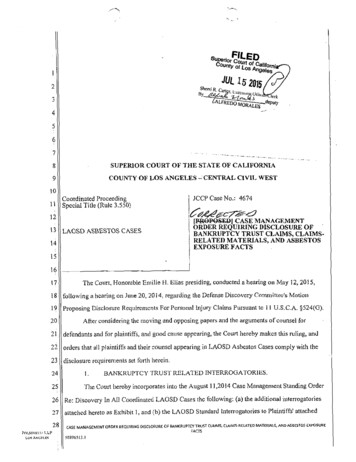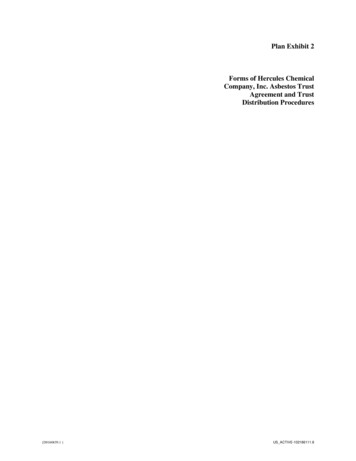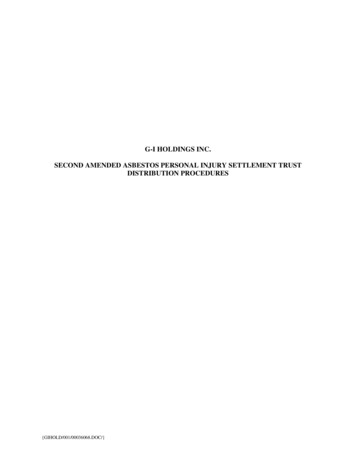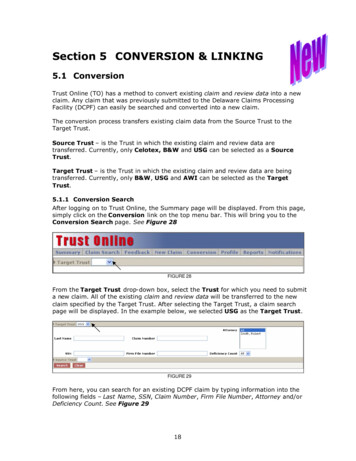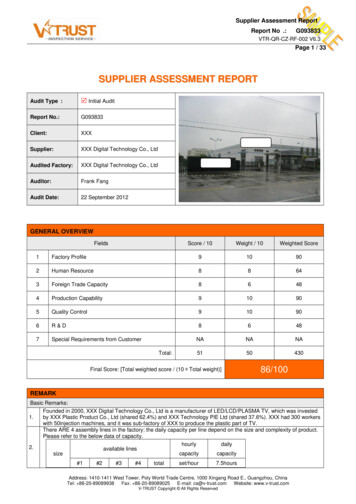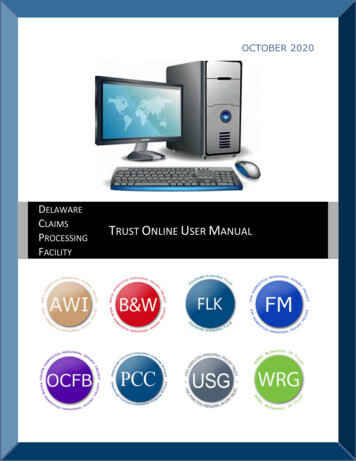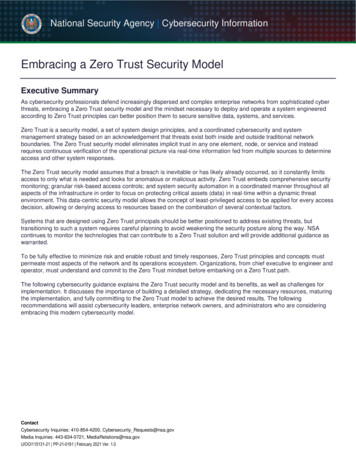
Transcription
National Security Agency Cybersecurity InformationEmbracing a Zero Trust Security ModelExecutive SummaryAs cybersecurity professionals defend increasingly dispersed and complex enterprise networks from sophisticated cyberthreats, embracing a Zero Trust security model and the mindset necessary to deploy and operate a system engineeredaccording to Zero Trust principles can better position them to secure sensitive data, systems, and services.Zero Trust is a security model, a set of system design principles, and a coordinated cybersecurity and systemmanagement strategy based on an acknowledgement that threats exist both inside and outside traditional networkboundaries. The Zero Trust security model eliminates implicit trust in any one element, node, or service and insteadrequires continuous verification of the operational picture via real-time information fed from multiple sources to determineaccess and other system responses.The Zero Trust security model assumes that a breach is inevitable or has likely already occurred, so it constantly limitsaccess to only what is needed and looks for anomalous or malicious activity. Zero Trust embeds comprehensive securitymonitoring; granular risk-based access controls; and system security automation in a coordinated manner throughout allaspects of the infrastructure in order to focus on protecting critical assets (data) in real-time within a dynamic threatenvironment. This data-centric security model allows the concept of least-privileged access to be applied for every accessdecision, allowing or denying access to resources based on the combination of several contextual factors.Systems that are designed using Zero Trust principals should be better positioned to address existing threats, buttransitioning to such a system requires careful planning to avoid weakening the security posture along the way. NSAcontinues to monitor the technologies that can contribute to a Zero Trust solution and will provide additional guidance aswarranted.To be fully effective to minimize risk and enable robust and timely responses, Zero Trust principles and concepts mustpermeate most aspects of the network and its operations ecosystem. Organizations, from chief executive to engineer andoperator, must understand and commit to the Zero Trust mindset before embarking on a Zero Trust path.The following cybersecurity guidance explains the Zero Trust security model and its benefits, as well as challenges forimplementation. It discusses the importance of building a detailed strategy, dedicating the necessary resources, maturingthe implementation, and fully committing to the Zero Trust model to achieve the desired results. The followingrecommendations will assist cybersecurity leaders, enterprise network owners, and administrators who are consideringembracing this modern cybersecurity model.ContactCybersecurity Inquiries: 410-854-4200, Cybersecurity Requests@nsa.govMedia Inquiries: 443-634-0721, MediaRelations@nsa.govU/OO/115131-21 PP-21-0191 February 2021 Ver. 1.0
NSA Embracing a Zero Trust Security ModelFalling behindToday’s IT landscape is empowered by a connected world that is more susceptible to malicious activity due to itsconnectedness, user diversity, wealth of devices, and globally distributed applications and services. Systems and usersrequire simple and secure methods of connecting and interacting with organizational resources, while also keepingmalicious actors at bay. The increasing complexity of current and emerging cloud, multi-cloud, and hybrid networkenvironments combined with the rapidly escalating and evolving nature of adversary threats has exposed the lack ofeffectiveness of traditional network cybersecurity defenses. Traditional perimeter-based network defenses with multiplelayers of disjointed security technologies have proven themselves to be unable to meet the cybersecurity needs due to thecurrent threat environment. Contemporary threat actors, from cyber criminals to nation-state actors, have become morepersistent, more stealthy, and more subtle; thus, they demonstrate an ability to penetrate network perimeter defenses withregularity. These threat actors, as well as insider threat actors, have succeeded in leveraging their access to endangerand inflict harm on national and economic security. Even the most skilled cybersecurity professionals are challengedwhen defending dispersed enterprise networks from ever more sophisticated cyber threats. Organizations need a betterway to secure their infrastructure and provide unified-yet-granular access control to data, services, applications, andinfrastructure.By implementing a modern cybersecurity strategy that integrates visibility from multiple vantage points, makes risk-awareaccess decisions, and automates detection and response actions, network defenders will be in a much better position tosecure sensitive data, systems, applications, and services. Zero Trust is an “assumed breach” security model that ismeant to guide cybersecurity architects, integrators, and implementers in integrating disparate but related cybersecuritycapabilities into a cohesive engine for cybersecurity decision-making. However, to be fully effective, Zero Trust principlesneed to permeate most aspects of the network and its operations ecosystem to minimize risk and enable robust andtimely responses. Organizations that choose to migrate to a Zero Trust solution should fully embrace this security modeland the mindset necessary for planning, resourcing, and operating under this security model to achieve the cybersecurityoutcomes that a Zero Trust solution can deliver [1] [2].Increasingly sophisticated threatsEmbracing a Zero Trust security model, and re-engineering an existing information system based on this security model,is a strategic effort that will take time to achieve full benefits. It is not a tactical mitigation response to new adversary tools,tactics, and techniques. However, several recent, highly publicized system breaches have exposed widespreadvulnerabilities in systems, as well as deficiencies in system management and defensive network operations. Theseincidents show that purely tactical responses are often insufficient. A mature Zero Trust environment will affordcybersecurity defenders more opportunities to detect novel threat actors, and more response options that can be quicklydeployed to address sophisticated threats. Adopting the mindset required to successfully operate a Zero Trustenvironment will further sensitize cybersecurity defenders to recognize ever more subtle threat indicators. Tacticalresponses will likely still be necessary even in a Zero Trust environment, but with the appropriate security model, mindset,and response tools, defenders can begin to react effectively to increasingly sophisticated threats.What is Zero Trust?Zero Trust is a security model, a set of system design principles, and a coordinated cybersecurity and systemmanagement strategy based on an acknowledgement that threats exist both inside and outside traditional networkboundaries. Zero Trust repeatedly questions the premise that users, devices, and network components should beimplicitly trusted based on their location within the network. Zero Trust embeds comprehensive security monitoring;granular, dynamic, and risk-based access controls; and system security automation in a coordinated manner throughoutall aspects of the infrastructure in order to focus specifically on protecting critical assets (data) in real-time within adynamic threat environment. This data-centric security model allows the concept of least privileged access to be appliedfor every access decision, where the answers to the questions of who, what, when, where, and how are critical forappropriately allowing or denying access to resources [3].NSA strongly recommends that a Zero Trust security model be considered for critical networks to include NationalSecurity Systems (NSS), Department of Defense (DoD) networks, and Defense Industrial Base (DIB) systems. IntegratingU/OO/115131-21 PP-21-0191 February 2021 Ver. 1.02
NSA Embracing a Zero Trust Security Modelthese principles within certain environments, especially within a large enterprise, can become complicated. To addressthese challenges, NSA is developing additional guidance to organize, guide, and simplify the Zero Trust design approach.Adopt a Zero Trust mindsetTo adequately address the modern dynamic threat environment requires: Coordinated and aggressive system monitoring, system management, and defensive operations capabilities.Assuming all requests for critical resources and all network traffic may be malicious.Assuming all devices and infrastructure may be compromised.Accepting that all access approvals to critical resources incur risk, and being prepared to perform rapid damageassessment, control, and recovery operations.Embrace Zero Trust guiding principlesA Zero Trust solution requires operational capabilities that: Never trust, always verify – Treat every user, device, application/workload, and data flow as untrusted.Authenticate and explicitly authorize each to the least privilege required using dynamic security policies.Assume breach – Consciously operate and defend resources with the assumption that an adversary already haspresence within the environment. Deny by default and heavily scrutinize all users, devices, data flows, and requestsfor access. Log, inspect, and continuously monitor all configuration changes, resource accesses, and network trafficfor suspicious activity.Verify explicitly – Access to all resources should be conducted in a consistent and secure manner using multipleattributes (dynamic and static) to derive confidence levels for contextual access decisions to resources.Leverage Zero Trust design conceptsWhen designing a Zero Trust solution: Define mission outcomes – Derive the Zero Trust architecture from organization-specific mission requirementsthat identify the critical Data/Assets/Applications/Services (DAAS).Architect from the inside out – First, focus on protecting critical DAAS. Second, secure all paths to access them.Determine who/what needs access to the DAAS to create access control policies – Create security policiesand apply them consistently across all environments (LAN, WAN, endpoint, perimeter, mobile, etc.).Inspect and log all traffic before acting – Establish full visibility of all activity across all layers from endpoints andthe network to enable analytics that can detect suspicious activity.Examples of Zero Trust in useThe fundamental purpose of Zero Trust is to understand and control how users, processes, and devices engage withdata. The combination of the user, device, and any other security-relevant contextual information (e.g., location, time ofday, previous logged behavior of the user or device) to be used to make an access decision is called a tuple. As part ofthis tuple, explicit authentication of both the user and the device is required to have reliable information in the tuple. TheZero Trust decision engine examines the tuple in the access request and compares that to the security policy for the dataor resource being requested. It then makes a risk-informed decision on whether to allow access and sends a log entry ofthat access request and decision to be part of future suspicious activity analytics. This process is conducted for everyindividual access request to each sensitive resource and can be repeated periodically during extended access to aresource.The following are a few example cases where a mature Zero Trust implementation can detect malicious activity betterthan a traditional architecture usually can.Compromised user credentialsIn this example, a malicious cyber actor compromises a legitimate user’s credentials and attempts to accessorganizational resources. In this case, the malicious actor is using an unauthorized device, either through remote accessU/OO/115131-21 PP-21-0191 February 2021 Ver. 1.03
NSA Embracing a Zero Trust Security Modelor with a rogue device joining the organization’s wireless LAN. In a traditional network the user’s credentials alone areoften sufficient to grant access, but in a Zero Trust environment the device is not known, so the device fails authenticationand authorization checks and so access is denied and the malicious activity is logged. In addition, Zero Trust requiresstrong authentication for user and device identities. Use of strong multi-factor authentication of users, which isrecommended for Zero Trust environments, can make stealing the user’s credentials more difficult in the first place.Remote exploitation or insider threatIn this example, a malicious cyber actor compromises a user’s device through an Internet-based mobile code exploit. Or,the actor is an inside authorized user with malicious intentions. In a typical, non-Zero Trust scenario, the actor uses theuser’s credentials, enumerates the network, escalates privileges, and moves laterally through the network to compromisevast stores of data and, ultimately, persist. In a Zero Trust network, the compromised user’s credentials and the deviceare already assumed to be malicious until proven otherwise, and the network is segmented, limiting both enumeration andlateral movement opportunities. While the malicious actor can authenticate as both the user and the device, access todata will be limited based on security policy, user role, and the user and device attributes. In a mature Zero Trustenvironment, data encryption and digital rights management may offer additional protections by limiting which data can beaccessed and the actions that can be taken with the sensitive data even if access was allowed. Further, analyticcapabilities continuously monitor for anomalous activity in accounts, devices, network activity, and data access. While alevel of compromise occurs in this scenario, damage is limited and the time for defensive systems to detect and initiateappropriate mitigating responses is greatly reduced.Figure 1: Example of Zero Trust remote exploitation scenarios where mostattempts would have been successful in non-Zero Trust environments.U/OO/115131-21 PP-21-0191 February 2021 Ver. 1.04
NSA Embracing a Zero Trust Security ModelCompromised supply chainIn this example, a malicious actor embeds malicious code in a popular enterprise network device or application. Thedevice or application is maintained and regularly updated on the organization’s network in accordance with best practices.In a traditional network architecture, this device or application would be internal and fully trusted. While this type ofcompromise can be particularly severe because it is implicitly so trusted, in a mature implementation of a Zero Trustarchitecture, real defensive cybersecurity benefits are obtained since the device or application would not be inherentlytrusted. Its privileges and access to data would be tightly controlled, minimized, and monitored; segmentation (macro andmicro) would be enforced by policy; and analytics would be used to monitor for anomalous activity. In addition, while thedevice may be able to download signed application updates (malicious or not), the device’s allowed network connectionsunder a Zero Trust design would employ a deny-by-default security policy, so any attempt to connect to other remoteaddresses for command and control would likely be blocked. Also, network monitoring could detect and block attemptedlateral movement from the device or an application not associated with an authorized access request.Zero Trust maturityImplementing Zero Trust takes time and effort: it cannot be implemented overnight. For many networks, existinginfrastructure can be leveraged and integrated to incorporate Zero Trust concepts, but the transition to a mature ZeroTrust architecture often requires additional capabilities to obtain the full benefits of a Zero Trust environment. Transitioningto a mature Zero Trust architecture all at once is also not necessary. Incorporating Zero Trust functionality incrementallyas part of a strategic plan can reduce risk accordingly at each step. As the Zero Trust implementation matures over time,enhanced visibility and automated responses allow defenders to keep pace with the threat.NSA recommends embracing the Zero Trust security model when considering how to integrate Zero Trust concepts intoan existing environment. Zero Trust efforts should be planned out as a continually maturing roadmap, from initialpreparation to basic, intermediate, and advanced stages, with cybersecurity protection, response, and operationsimproving over time.Figure 2: Maturing a Zero Trust implementationU/OO/115131-21 PP-21-0191 February 2021 Ver. 1.05
NSA Embracing a Zero Trust Security ModelPotential challenges on the path to Zero TrustWhen implementing Zero Trust in enterprise networks, several challenges may arise that reduce the effectiveness of thesolution. The first potential challenge is a lack of full support throughout the enterprise, possibly from leadership,administrators, or users. The mindset required for Zero Trust must be embraced fully for any solution to be successful. Ifleaders are unwilling to spend the necessary resources to build and sustain it, if administrators and network defenders donot have buy-in or the requisite expertise, or if users are allowed to circumvent the policies, then the benefits of Zero Trustwill not be realized in that environment. Once even basic or intermediate Zero Trust capabilities are integrated into anetwork, follow-through is necessary to mature the implementation and achieve full benefits [4].With the pervasive need for Zero Trust concepts to be applied throughout the environment, scalability of the capabilities isessential. Access control decisions that may have only occurred once for each access previously will now be performedcontinuously as access to the resource is used, requiring a robust infrastructure for making, enforcing, and then loggingthese access decisions. In addition, elements of the network that previously were not part of access control decisions maybecome essential elements whose reliability and consistent use are required, such as data tags and additional networksensors.Persistent adherence to the mindset, and application of the Zero Trust security model over time is also a key requirement.Administrators and defenders may become fatigued with constantly applying default-deny security policies and alwaysassuming a breach is occurring, but if the Zero Trust approach falters, then its cybersecurity benefits become significantlydegraded or eliminated.Carefully minimizing embedded trust empowers a more secure missionThe ever-increasing complexity of network environments and the ability of adversaries to compromise them requires achange in defensive focus. The Zero Trust mindset focuses on securing critical data and access paths by eliminating trustas much as possible, coupled with verifying and regularly re-verifying every allowed access. However, implementing ZeroTrust should not be undertaken lightly and will require significant resources and persistence to achieve. When properlyand fully implemented, Zero Trust should be able to prevent, detect, and contain intrusions significantly faster and moreeffectively than traditional, less integrated cybersecurity architectures and approaches. Further guidanceNSA is assisting DoD customers in piloting Zero Trust systems, coordinating activities with existing NSS and DoDprograms, and developing additional Zero Trust guidance to support system developers through the challenges ofintegrating Zero Trust within NSS, DoD, and DIB environments. Upcoming additional guidance will help organize, guide,and simplify incorporating Zero Trust principles and designs into enterprise networks. The National Institute of Standardsand Technology also has related Zero Trust architecture guidance [3].Supplementary NSA guidance on ensuring a secure and defensible network environment is available athttps://www.nsa.gov/cybersecurity-guidance. Of particular relevance are: NSA’s Top Ten Cybersecurity Mitigation StrategiesDefend Privileges and AccountsContinuously Hunt for Network IntrusionsSegment Networks and Deploy Application-aware DefensesTransition to Multi-factor AuthenticationActively Manage Systems and ConfigurationsPerforming Out-of-Band Network ManagementHardening SIEM SolutionsMitigating Cloud VulnerabilitiesU/OO/115131-21 PP-21-0191 February 2021 Ver. 1.06
NSA Embracing a Zero Trust Security ModelWorks Cited[1][2][3][4]Department of Defense (2019), DoD Digital Modernization Strategy. Available at: irector, Operational Test and Evaluation (2021), FY 2020 Annual Report. Available /FY2020/other/2020DOTEAnnualReport.pdfNational Institute of Standards and Technology (2020), Special Publication 800-207: Zero Trust Architecture. Available 0-207/finalInstitute for Defense Analysis (2015), In-Use and Emerging Disruptive Technology Trends. Available at: imer of EndorsementThe information and opinions contained in this document are provided "as is" and without any warranties or guarantees. Reference herein to any specificcommercial products, process, or service by trade name, trademark, manufacturer, or otherwise, does not constitute or imply its endorsement,recommendation, or favoring by the United States Government, and this guidance shall not be used for advertising or product endorsement purposes.PurposeThis document was developed in furtherance of NSA’s cybersecurity missions, including its responsibilities to identify and disseminate threats toNational Security Systems, Department of Defense, and Defense Industrial Base information systems, and to develop and issue cybersecurityspecifications and mitigations. This information may be shared broadly to reach all appropriate stakeholders.ContactClient Requirements / General Cybersecurity Inquiries: Cybersecurity Requirements Center, 410-854-4200, Cybersecurity Requests@nsa.govMedia Inquiries / Press Desk: Media Relations, 443-634-0721, MediaRelations@nsa.govU/OO/115131-21 PP-21-0191 February 2021 Ver. 1.07
Feb 25, 2021 · Zero Trust is a security model, a set of system design principles, and a coordinated cybersecurity and system management strategy based on an acknowledgement that threats exist both inside and outside traditional network boundaries. The Zero Trust security model eliminates implic
